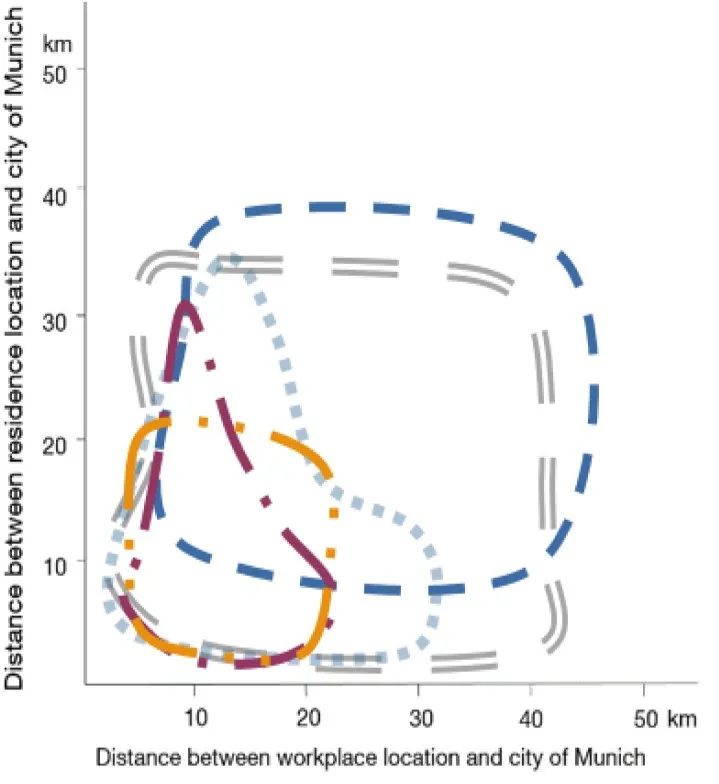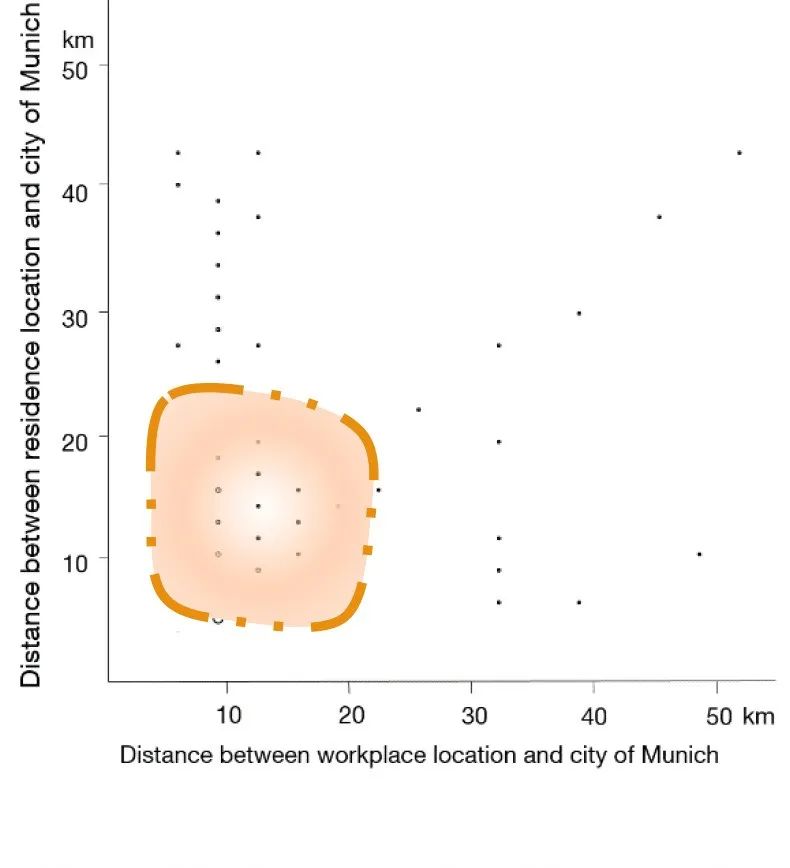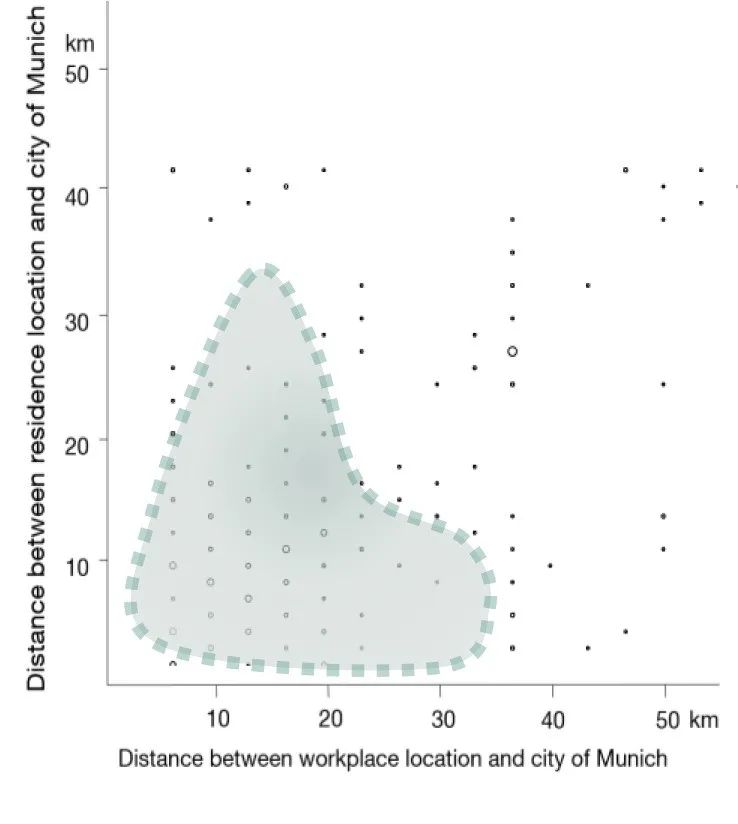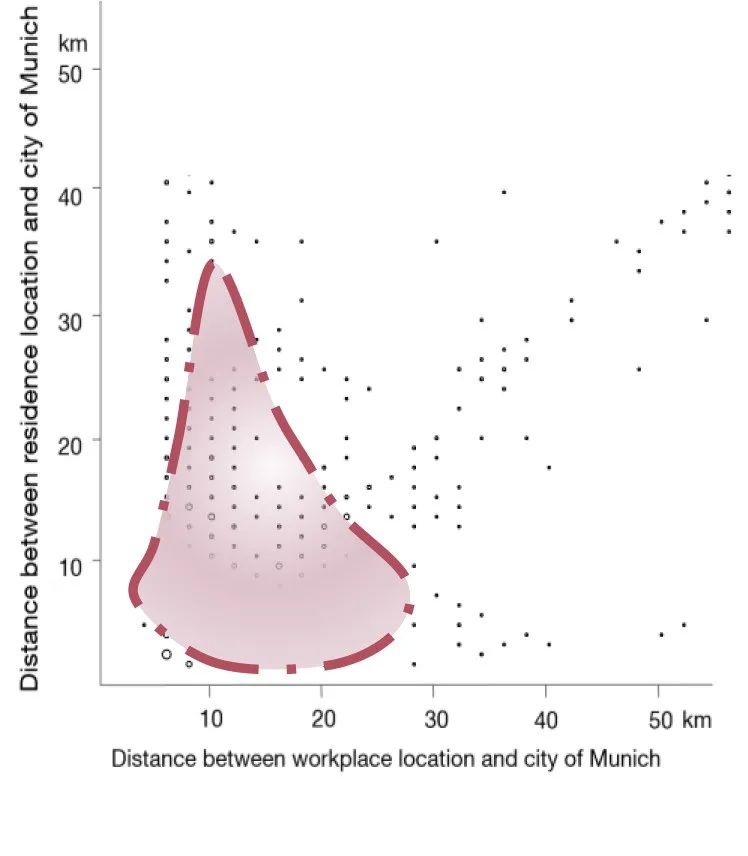国家自然科学基金项目(41901188)资助
研究方向:城市地理学、行为地理学
首都师范大学资源环境与旅游学院,讲师,硕士生导师
知识工作者作为重要的创新要素,是创新型城市建设及区域发展的关键驱动力。为助力北京建成具有全球影响力的科技创新中心,有必要掌握知识工作者职住及休闲空间的满意度及其决策机制。然而,已有研究很少关注到异质性的知识工作者在区域内部的差异性空间偏好,且较少有实证研究关注国内城市案例。本课题运用创新地理学及行为地理学的理论,基于POI数据、问卷数据及半结构式访谈,旨在探究以下三个研究问题:第一,知识工作者的职住空间满意度及其潜在偏好;第二,知识工作者的休闲与职住空间的依存关系;第三,知识工作者的休闲空间满意度对北京第三空间规划的启示。研究成果将启发北京进一步完善其软硬空间环境来促使知识工作者长期定居北京,一方面提升其满意度水平;另一方面促使其产生知识溢出效应,驱动北京的区域创新。
1. 交叉研究:以知识工作者为枢纽,结合创新地理、行为地理与城市地理的理论,对北京生产空间和生活空间(就业、居住、通勤与休闲空间)进行深入分析
2. 多源数据:融合大数据、网络问卷数据及半结构化访谈等多源数据
21世纪是以人才资源开发为时代动力的崭新世纪[1]。2016年5月,中共中央、国务院印发了《国家创新驱动发展战略纲要》,加快实施国家创新驱动发展战略。知识工作者/创新人才作为重要的创新要素[2],是创新型城市建设以及区域发展的关键驱动力[3-8]。如何吸引知识工作者成为城市政策制定者面临的紧迫问题[9],国内一二线城市上演了激烈的“人才争夺战”[10]。城市发展和竞争的逻辑也相继出现新变化,不同于以往的“业兴人,人兴城”模式,“城兴人,人兴业”模式以改善城市生态环境和促进多元文化来吸引人才,进而发展产业,最终实现城市的可持续发展,提升城市吸引力来提升城市竞争力和影响力[11]。鉴于高质量的职住与休闲环境是城市吸引力的重要因素,为助力北京建成具有全球影响力的科技创新中心,有必要了解和掌握创新人才职住、通勤以及休闲活动的空间偏好及其决策机制[12-13]。
本课题具有以下两个方面的研究意义:第一,通过改善职住环境规划来提升知识工作者定居北京的意愿,产生知识溢出效应,从而驱动北京创新;第二,明晰北京第三空间规划与北京生活圈规划的区别与联系,并对其进行有效指导,提升其整体满意度水平。
本项目旨在探究以下三个问题:
第一,如何通过知识工作者的职住空间规律及满意度推断其潜在空间偏好?
第二,知识工作者的休闲空间与其职住空间存在何种依存关系?
第三,知识工作者的休闲空间满意度对北京“第三空间”规划有何启示?
1. 由于不同的知识类型因其显隐性成分差异而导致地理空间敏感度不同,其空间响应也有所差异,已有研究较多关注三元知识类型(分析型、合成型及符号型知识)对知识密集型企业的创新网络和产业布局的影响(图1)[14]。然而,很少有研究关注到知识类型对创新人才个体决策层面的影响(图2)[15-27]。
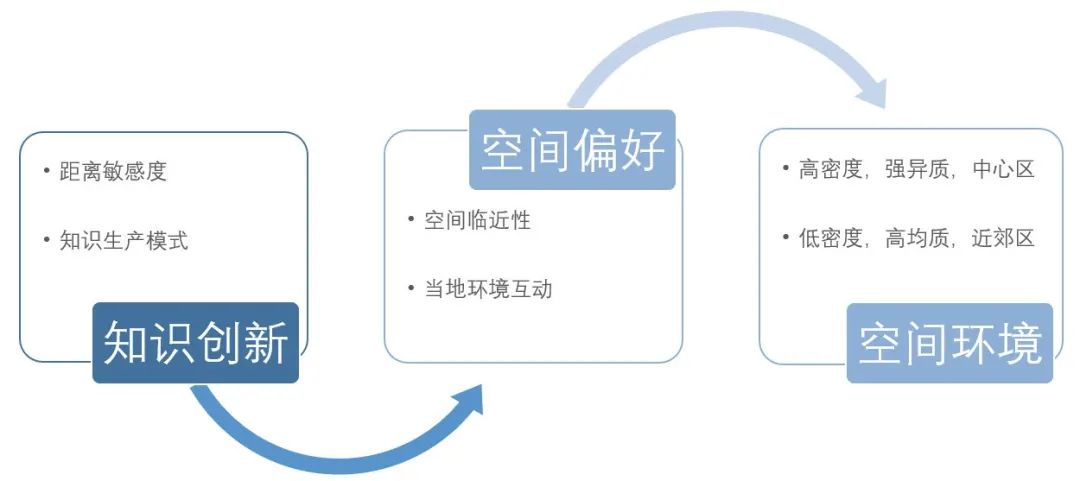
图1. 知识创新模式通过作用空间偏好进而影响空间环境的选择
(来源:Zhao, 2017[14])
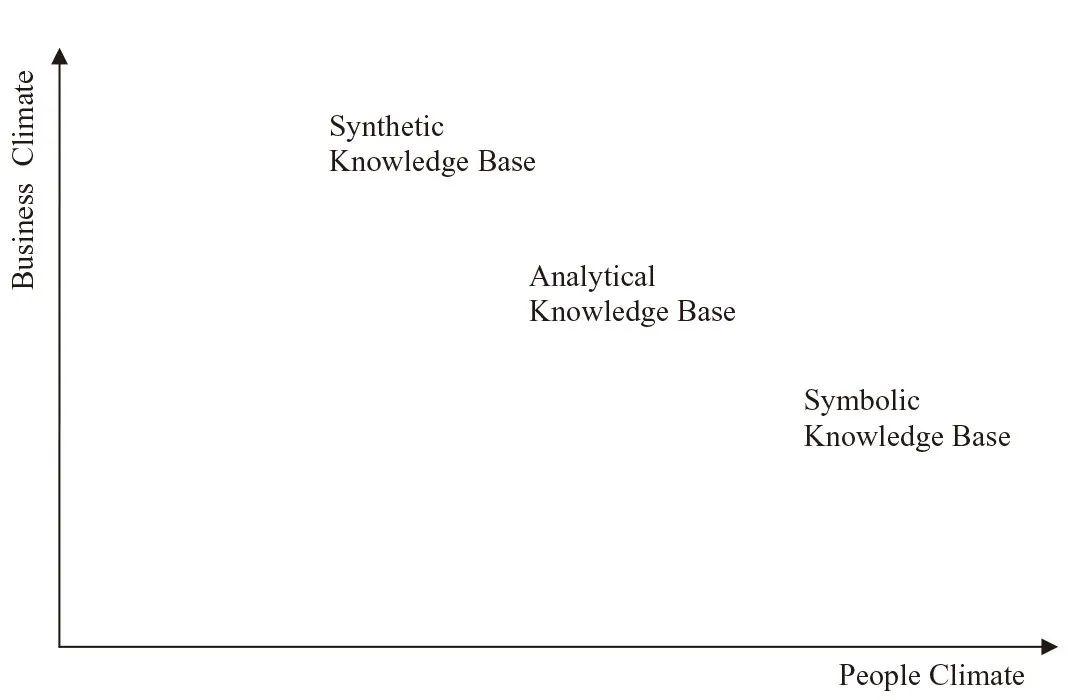
图2. 不同类型知识工作者在居住区位选择时对商业氛围和人文氛围的偏好
(来源:Asheim and Hansen, 2009[15])
2. 已有研究更多关注城市如何吸引而非如何留住知识工作者,即关注知识工作者集聚与城市特征间的相关性(知识工作者在区域之间的迁移动机与机制研究),而非探究知识工作者在定居大都市区后对其职住区位进一步优化的需求和满意度水平[9,12,28-38]。
3. 已有研究较多从收入水平、年龄、家庭构成、教育程度及对特定交通方式的偏好出发来研究知识工作者职住区位的选择及其空间分异特征(图3)[39],还未能从知识类型视角去剖析其对区域内空间偏好的作用[33,40-52]。
图 3. 一般学历工作者(左)与较高学历工作者(右)的通勤空间形态
(来源:Burger et al., 2014[39])
4. 已有研究较多将创新人才当作一个均质群体,且其关于其空间偏好的研究结果尚无统一定论,未能对其内部异质性进一步深入探究[46-52]。
图 4. 不同类型知识工作者与其他工作者的职住区位偏好
(蓝色:工程型;橘色:艺术型;绿色:科研型;红色:商务型;灰色:其他工作者)
(来源:Zhao, 2017 [14])
5. 已有实证研究多以西方(美国、德国、加拿大、荷兰等)城市为例,对不同类型创新人才的差异性空间偏好有了初步分析[14](图4),但未能进一步阐明其决策机制[15,19,54-55]。因此,有必要对国内城市的知识工作者空间偏好进行实证研究。
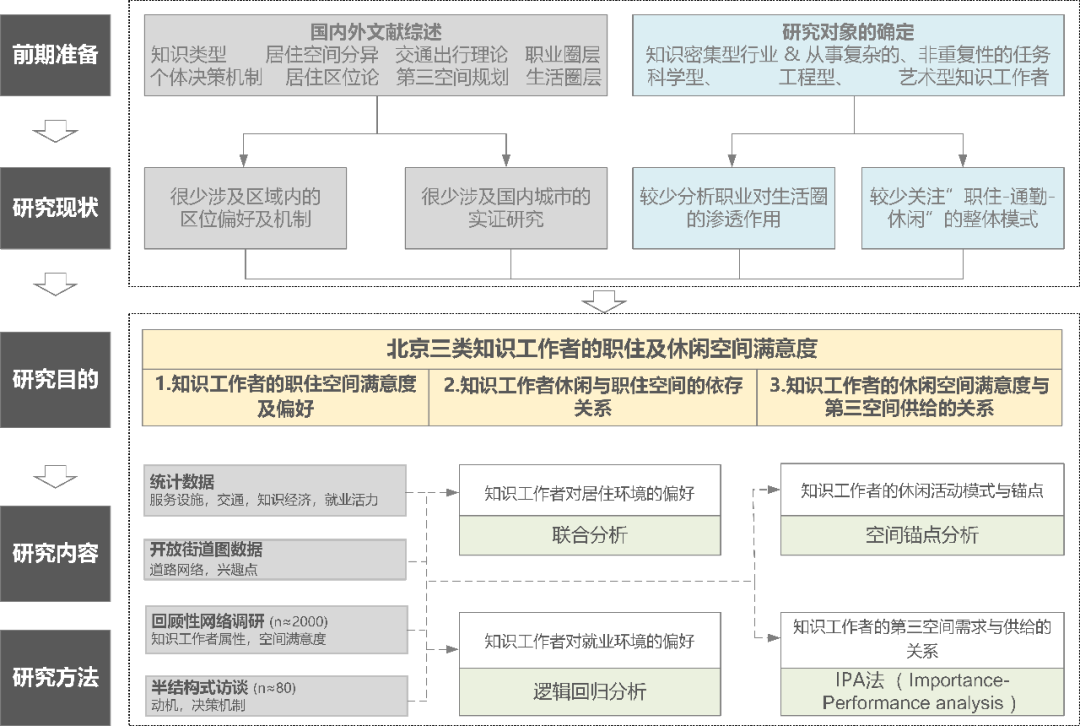
图5. 本项目的技术路线 (来源:项目组自绘)
1. 总结知识工作者的职住空间满意度,并推断其异质性的空间偏好
2. 通过知识工作者的职住空间与休闲空间关系来判断其休闲活动模式及锚点
3. 总结知识工作者的休闲空间满意度,评价北京第三空间规划的已有绩效及改进潜力
本研究结合线下实地调研和线上发放网络问卷两个渠道,目标获取2000份问卷数据。2020年10月,我们前往798艺术区、中关村软件园、丰台科技园、CBD、玉渊潭公园、紫竹苑公园、莲花池公园等10多个地点进行了实地调研,线下仅获取了500份问卷。10月24日,我们线上渠道正式发布,获取了700多份问卷。我们仍需搜集800份数据才能支撑后续分析。
若您或您的家人朋友有在工程/金融/文艺/科研等行业工作,我们由衷地希望您可以扫描下方的问卷二维码(图6)或打开链接填写一下,仅需5~8分钟;为表达谢意,提交后可领取红包并参与抽奖(图7)。如您对我们的项目感兴趣,也非常希望您可以帮忙转发一下,万分感谢!
【问卷链接】:
https://www.wenjuan.com/s/uQ3mm2Q/
(复制至浏览器搜索或点击文末阅读原文)
 图6. 本项目的宣传海报及问卷二维码
图6. 本项目的宣传海报及问卷二维码
图7. 填写项目问卷的答谢方式
图8. 项目团队在线下实地发放问卷
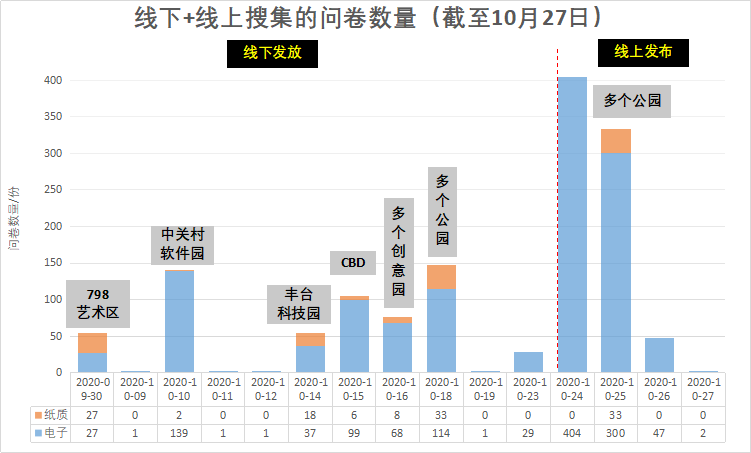
图9. 本课题组通过线下发放和线上发布搜集到的问卷数量(截至到10月27日)
· Zhao, Juanjuan: knowledge base shapes use of space: knowledge-workers’ interrelated choices of residence, workplace and commute within the metropolitan region of Munich. TUM Bibliothek- SVH. 1-259. (2019)
· Yan Gu, Juanjuan Zhao*, Thomas Herzog, Qizhi Mao, Peter Latz, Exploring the space use mechanism of high-density campus in urban Beijing, Habitat International,91,1-15. (2019)
· 赵娟娟*. 知识工作者.城市与区域规划研究.10.1:12-25. (2018)
· Zhao, Juanjuan*; Michael, Bentlage; Alain, Thierstein: “Residence, workplace and commute: Interrelated spatial choices of knowledge workers in the metropolitan region of Munich.” Journal of Transport Geography 62, 197-212. (2017)
· Zhao, Juanjuan*; Michael, Bentlage; Alain, Thierstein: “‘Knowledge-Workers’: A Conceptual Framework on Commuting Patterns.” Sustainable Mobility in Metropolitan Regions, Springer VS, 99-121. (2016)
· Büttner, Benjamin; Zhao, Juanjuan; Thierstein, Alain; Wulfhorst, Gebhard; Förster, Agnes; Sterzer, Lena: When growth stresses development. Interdependencies between housing, employment and mobility in the Munich metropolitan region. RSAI 10th World Congress Proceedings, Bangkok. (2014)
[1] 叶忠海. (2009). 人才地理学概论: 高等教育出版社
[2] 黄亮, & 杜德斌. (2014). 创新型城市研究的理论演进与反思. 地理科学进展, 34(07), 773-779.
[3] Florida, R. (2002a). The economic geography of talent. Annals of the Association of American geographers, 92(4), 743-755.
[4] 曾刚. (2016). 上海建设全球城市的战略框架和战略重点. 科学发展(03), 99-105.
[5] 方创琳, 马海涛, 王振波, & 李广东. (2014). 中国创新型城市建设的综合评估与空间格局分异. 地理学报, 69(04), 459-473.
[6] 郭泉恩, & 孙斌栋. (2017). 官产学合作是否促进了区域创新——来自中国地级及以上城市的证据. 教育学术月刊(08), 29-40.
[7] 吕拉昌, 孙飞翔, & 黄茹. (2018). 基于创新的城市化——中国 270 个地级及以上城市数据的实证分析. 地理学报, 73(10), 1910-1922.
[8] 王婷, & 孙斌栋. (2015). 技术创新在城市经济增长中的作用. 城市问题(02), 57-63.
[9] 肖昕茹. (2008). 人才地理学研究综述. 人才开发(08), 8-9.
[10] 张国玉. (2018). 专家解读:为什么会爆发“人才争夺战”?Retrieved from https://www.sohu.com/a/233473531_100082391
[11] Landry, C. (2012). The creative city: A toolkit for urban innovators: Routledge.
[12] Darchen, S., & Tremblay, D.-G. (2010). What attracts and retains knowledge workers/students: The quality of place or career opportunities? The cases of Montreal and Ottawa. Cities, 27(4), 225-233. doi:http://dx.doi.org/10.1016/j.cities.2009.12.009
[13] Frenkel,A., Bendit, E. & Kaplan, S. 2013. The linkage between the lifestyle of knowledge-workers and their intra-metropolitan residential choice: A clustering approach based on self-organizing maps. Computers, Environment and Urban Systems, 39, 151-161.
[14] Zhao, J. 2017. Knowledge base shapes use of space: knowledge workers’ interrelated choices of residence, workplace and commute in the metropolitan region of Munich. Dissertation, Technical University of Munich.
[15] Asheim, B. & Hansen, H. K. 2009. Knowledge bases, talents, and contexts: On the usefulness of the creative class approach in Sweden. Economic Geography, 85, 425-442.
[16] 张翼鸥, & 谷人旭. (2018). 中国城市知识复杂性的空间特征及影响研究. 地理学报, 73(08), 1421-1432.
[17] Nonaka, I., & Nishiguchi, T. (2000). Knowledge emergence: Social, technical, and evolutionary dimensions of knowledge creation. New Y ork: Oxford University Press.
[18] Skytt-Larsen, C. B., & Winther, L. (2015). Knowledge production, urban locations and the importance of local networks. European Planning Studies, 23(9), 1895-1917.
[19] Spencer, G. M. (2015). Knowledge neighbourhoods: Urban form and evolutionary economic geography. Regional Studies, 49(5), 883-898.
[20] Storper, M., & Scott, A. J. (2009). Rethinking human capital, creativity and urban growth. Journal of Economic Geography, 9(2), 147-167. doi:10.1093/jeg/lbn052
[21] 李美桂, 赵兰香, 姚升保, & 陈锐. (2018). 面向科技创新中心建设的产业知识基础评析——以北京科技创新中心为例. 科技进步与对策, 35(08), 52-59.
[22] 叶琴, & 曾刚. (2018). 解析型与合成型产业创新网络特征比较——以中国生物医药、节能环保产业为例. 经济地理, 38(10), 142-154.
[23] Münter, A., & V olgmann, K. (2014). The Metropolization and Regionalization of the Knowledge Economy in the Multi-Core Rhine-Ruhr Metropolitan Region. European Planning Studies, 22(12), 2542-2560. doi:10.1080/09654313.2013.844776
[24] 牛盼强. (2016). 上海产业知识基础与制度协调研究——基于全球科创中心的建设. 科学学研究, 34(06), 860-866.
[25] 牛盼强, & 谢富纪. (2011). 综合型知识基础与解析型知识基础的比较研究. 科学学研究, 29(01), 25-30.
[26] Asheim, B., Boschma, R., & Cooke, P . (2011). Constructing Regional Advantage: Platform Policies Based on Related V ariety and Differentiated Knowledge Bases. Regional Studies, 45(7), 893-904.
[27] Moodysson, J., Coenen, L., & Asheim, B. (2008). Explaining spatial patterns of innovation: analytical and synthetic modes of knowledge creation in the Medicon V alley life-science cluster. Environment and Planning A, 40(5), 1040-1056.
[28] 徐宝芳. (1999). 人才地理学研究. 人文地理(S1), 64-67.
[29] Florida, R., Mellander, C., Stolarick, K., & Ross, A. (2012). Cities, skills and wages. Journal of Economic Geography, 12(2), 355-377. doi:10.1093/jeg/lbr017
[30] Straubhaar, T. (2000). International mobility of the highly skilled: Brain gain, brain drain or brain exchange. Retrieved from http://citeseerx.ist.psu.edu/viewdoc/download?doi=10.1.1.557.9988&rep=rep1&type=pdf
[31] Yigitcanlar, T., & Martinez-Fernandez, M. C. (2007). Making Space and Place for Knowledge Production: Knowledge Precinct Developments in Australia. Paper presented at the Proceedings 2007 State of Australian Cities Conference (SOAC), Adelaide.
[32] Storper, M., & Manville, M. (2006). Behaviour, Preferences and Cities: Urban Theory and Urban Resurgence. Urban studies, 43(8), 1247–1274.
[33] 陈刚. (2011). 福建省信息产业人才空间分布与开发研究. (硕士), 福州大学, Available from Cnki
[34] 谷人旭, & 许波. (2001). 区域人才资源开发及其优化管理问题探讨——以上海市为例. 经济地理(02), 150-154.
[35] 王蕾. (2017). 人才地理分布研究综述. 产业与科技论坛, 16(24), 112-113.
[36] Kim, T.-K., Horner, M. W., & Marans, R. W. (2005). Life Cycle and Environmental Factors in Selecting Residential and Job Locations. Housing Studies, 20(3), 457-473. doi:10.1080/02673030500062335
[37] Thierstein, A., Förster, A., Conventz, S., Erhard, K., & Ottmann, M. (2013). W ohnungsnachfrage im Großraum München. Individuelle Präferenzen, verfügbares Angebot und räumliche Maßstabsebenen. Retrieved from München: https://mediatum.ub.tum.de/doc/1169938/1169938.pdf
[38] Yigitcanlar, T. (2010). Making space and place for the knowledge economy: knowledge-based development of Australian cities. European Planning Studies, 18(11), 1769-1786.
[39] Burger, M. J., Van Der Knaap B. & Wall, R. S. 2014. Polycentricity and the Multiplexity of Urban Networks. European Planning Studies, 22, 816-840.
[40] Ko, J., Lee, S., & Byun, M. (2019). Exploring factors associated with commute mode choice: An application of city-level general social survey data. Transport Policy, 75, 36-46. doi:https://doi.org/10.1016/j.tranpol.2018.12.007
[41] Beamish, J. O., Carucci Goss, R., & Emmel, J. (2001). Lifestyle Influences on Housing Preferences. Housing and Society, 28(1-2), 1-28. doi:10.1080/08882746.2001.11430459
[42] Couture, V ., & Handbury, J. (2017). Urban revival in America, 2000 to 2010. Retrieved from https://www.nber.org/papers/w24084
[43] Pinjari, A. R., Bhat, C. R., & Hensher, D. A. (2009). Residential self-selection effects in an activity time-use behavior model. Transportation Research Part B: Methodological, 43(7), 729-748.
[44] van de Coevering, P ., Maat, K., & van Wee, B. (2018). Residential self-selection, reverse causality and residential dissonance. A latent class transition model of interactions between the built environment, travel attitudes and travel behavior. Transportation Research Part A: Policy and Practice, 118, 466-479.
[45] Maloutas, T., & Spyrellis, S. N. (2019). Segregation trends in Athens: the changing residential distribution of occupational categories during the 2000s. Regional Studies, 1-10. doi:10.1080/00343404.2018.1556392
[46] Beckers, P ., & Boschman, S. (2019). Residential choices of foreign highly skilled workers in the Netherlands and the role of neighbourhood and urban regional characteristics. Urban studies, 56(4), 760-777. doi:10.1177/0042098017741262
[47] Florida, R. (2002b). The rise of the creative class: and how it’s transforming work, leisure, community and everyday life. New Y ork: Basic Books.
[48] Haisch, T., & Klöpper, C. (2015). Location choices of the creative class: does tolerance make a difference? Journal of Urban Affairs, 37(3), 233-254. doi:10.1111/juaf.12148
[49] Kunzmann, K. R. (2009). The strategic dimensions of knowledge industries in urban development. disP-The Planning Review, 45(177), 40-47.
[50] Lee, P ., Burfitt, A., & Tice, A. (2009). The creative economy and social sustainability: Planning for opportunity and growth. Built Environment, 35(2), 267-280.
[51] Glaeser, E. (2005). Review of Richard Florida’s The Rise of the Creative Class. Regional science and urban economics, 35(5), 593-596.
[52] Felsenstein, D. (2002). Do high technology agglomerations encourage urban sprawl? The Annals of Regional Science, 36(4), 663-682.
[53] Zhao, J., Bentlage, M., & Thierstein, A. (2017). Residence, workplace and commute: Interrelated spatial choices of knowledge workers in the metropolitan region of Munich. Journal of Transport Geography, 62, 197-212. doi:https://doi.org/10.1016/j.jtrangeo.2017.05.012
[54] Musterd, S. (2006). Segregation, urban space and the resurgent city. Urban studies, 43(8), 1325-1340.
[55] Frenkel, A., Bendit, E., & Kaplan, S. (2013). Residential location choice of knowledge-workers: The role of amenities, workplace and lifestyle. Cities, 35, 33-41.

更多内容,请点击微信下方菜单即可查询。
请搜索微信号“Beijingcitylab”关注。
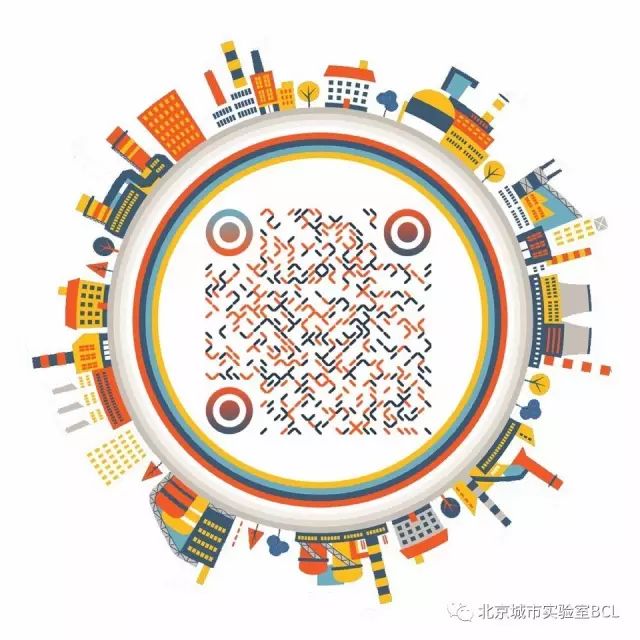
Email:BeijingCityLab@gmail.com
Emaillist: BCL@freelist.org
新浪微博:北京城市实验室BCL
微信号:beijingcitylab
网址: http://www.beijingcitylab.com
责任编辑:孟庆祥







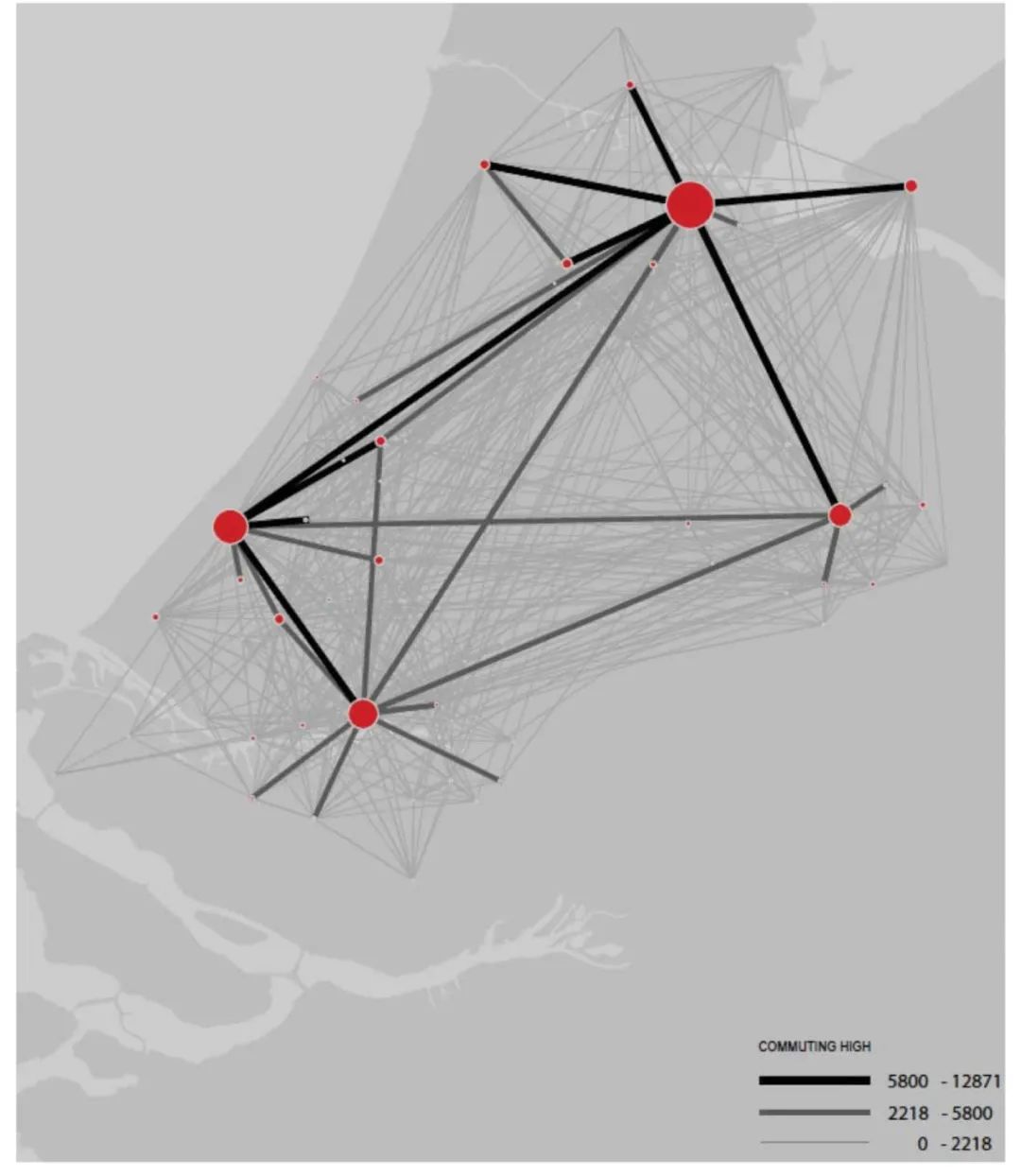

 图6. 本项目的宣传海报及问卷二维码
图6. 本项目的宣传海报及问卷二维码

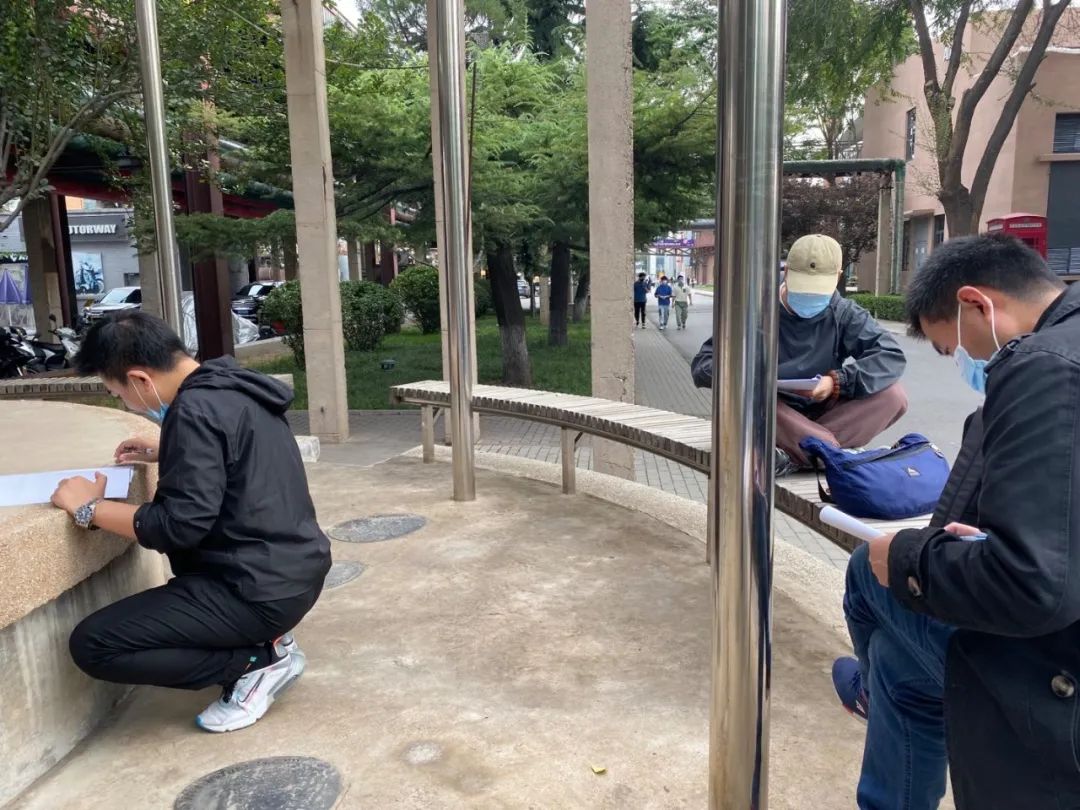

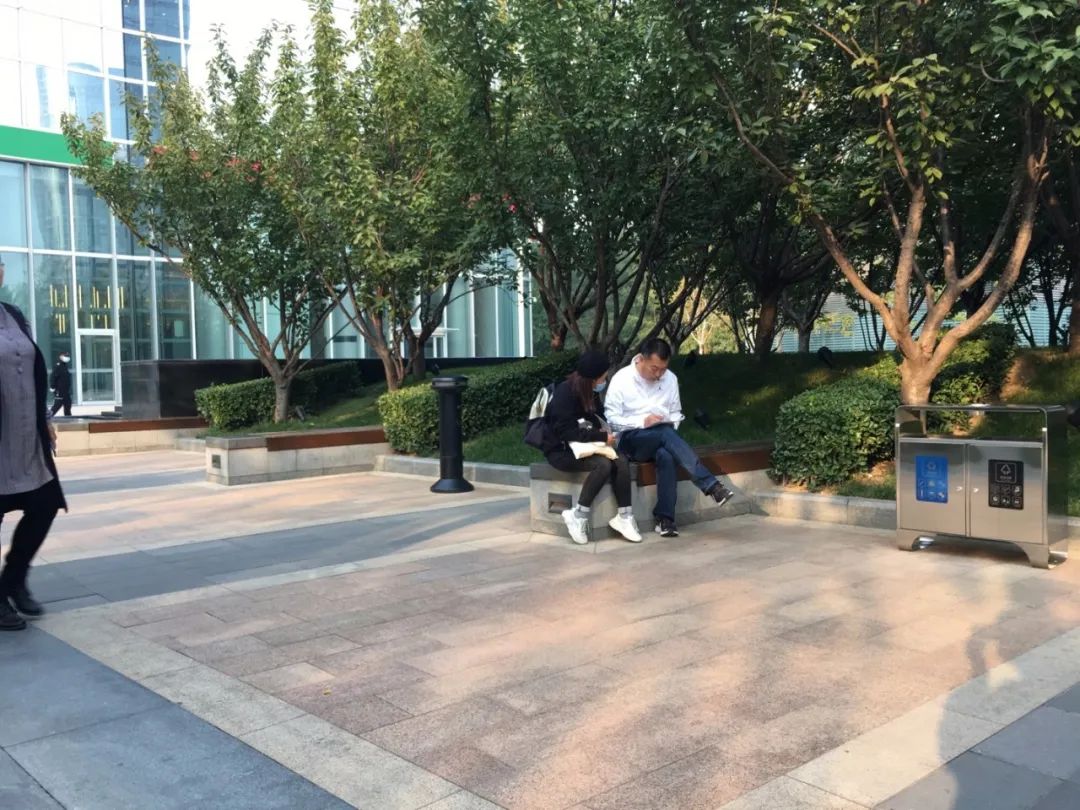
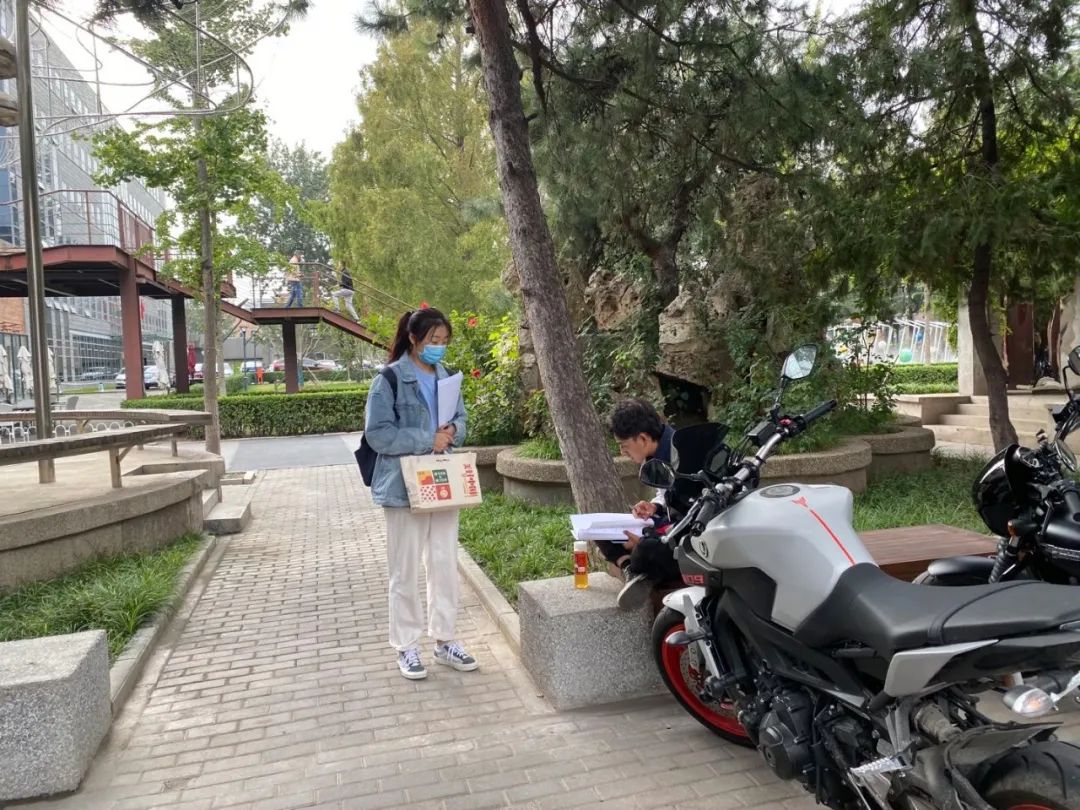



 规划问道
规划问道